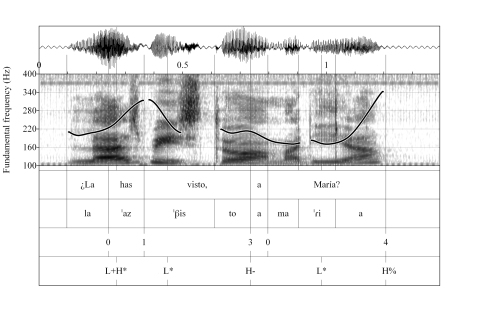Break indices of level 3 (BI 3) correspond to the end of minor prosodic units: they mark the boundaries of intermediate phrases (ips).
Example
¿La has visto, a Maria?
[Have you seen Mary?]

In this example, there are three prosodic words: La has, visto, and a María, assembled in two intermediate phrases (ip): La has visto and a María.
The first pitch accent is beared by the auxiliary verb has, the second one is aligned with the stressed syllable vis- of the past participle visto, and the third one is on the stressed syllable -rí- of María.
The three PrWord are separated from one another by break indices of at least level 1. Between La has and visto, there is no perceived break and they are separated by a BI 1, but between visto and a María, the prosodic rupture is higher: there is an ip boundary, which is tonally marked by a H- boundary tone on the last syllable of the first ip, -to. This rise cannot be attributed to the pitch accent on the stressed syllable since it is a H+L*, so it must be interpreted as a H- boundary tone.
Boundary tones only occur at breaks of level 3 or 4. Here, the perceived disjuncture in not very strong: La has visto is an intermediate phrase. So, the boundary between the two first PrWords La has visto and a María has to be labelled BI 3.
- To see how to discriminate between BI 3 and BI 4: click here
